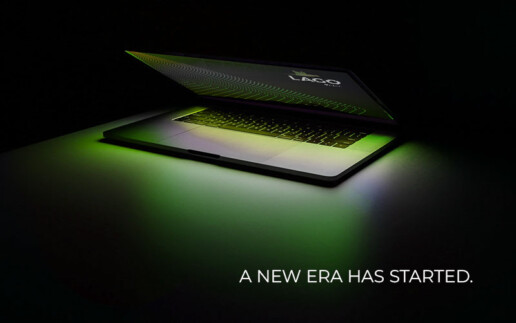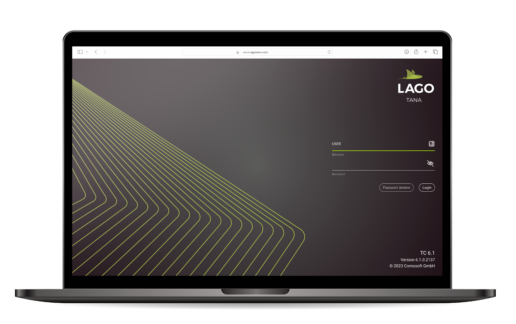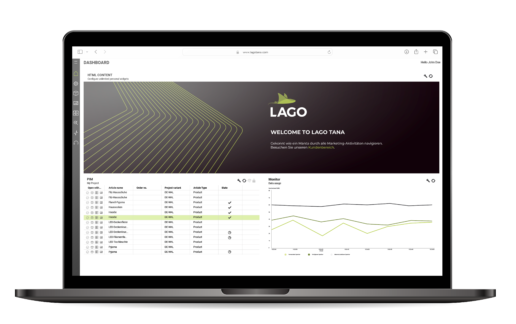LAGO TANA Release
LAGO TANA – Explore a whole new version of LAGO!
Improved interface, streamlined features and proven workflows:
With this release Comosoft enters a new era of LAGO versions – Beginning with the name Tana and a new LAGO logo. If you ever happened to have an encounter with a manta ray, our new logo mascot, you met one of the most calm and majestic animals on the planet. The version name Tana refers to the biggest lake in Ethiopia, which is the water mouth of the Blue Nile, and the surrounding prolific reserve.
HIGHLIGHTS
A completely new look and feel of LAGO is a long awaited change and above all reflects the new modern technology behind LAGO TANA. Despite the new UI, LAGO retains the familiar user experience. The most impact will be brought by the flat design and a general brighter appearance of the interface. Calm sections with reduced design elements will help users focus on their tasks.
Better overview, faster access. The new LAGO Dashboard, included in our web client will greet all users upon login and before navigating into one of our various applications.
LAGO Dashboard allows to configure global and personal dashboards. Global dashboards can be shared with user groups to ensure that users of the same group have access to the same information. Optionally users can create their own dashboards. Editing the layout of a dashboard is easily done by simple drag and drop actions.
For the content of the dashboards, various widgets are available, such as a global job list, which allows to directly jump into different application depending on the job (e.g. opening a document directly in LAGO Whiteboard or LAGO Proof). The widget “Search Results”, which is based on search folders contains quick links into the applications (e.g. to directly edit an article shown in a filter). LAGO Dashboard can also be used to distribute information such as announcements or links to other important resources, using the widget “HTML Content”.
For over 20 years, LAGO has been using Adobe Photoshop® to process assets for various use cases, from which the import of assets is the main use case. With more parts of the application moving towards the server and aways from client applications, the usage of Adobe Photoshop® has become challenging for IT departments.
The solution is the LAGO Asset Processor, which is the server-based solution for LAGO Pict with Adobe Photoshop®. LAGO Asset Processor runs on the LAGO Application Server (“LAS”) as a servlet within Apache Tomcat and performs asset processing for import and export purposes without the need of Adobe Photoshop®. It is designed for scalability and allows the setup of multiple instances in multiple Apache Tomcats if needed. It is also possible to assign different tasks to different LAGO Asset Processor instances.
Configuration and management of LAGO Asset Processor is being done within LAGO Admin, where instances, tasks and task configurations (e.g. “Hotfolder” configurations) can be configured. The logging and activity can be viewed within LAGO Monitor. The tasks can be activated and deactivated on the fly without having to restart the LAS.
The LAGO Asset Server within LAGO Pict, including the plugin for Adobe Photoshop® is still available with LAGO TANA. However, asset processing without Adobe Photoshop® is only possible when using the LAGO Asset Processor.
The module “LAGO History” including the corresponding application LAGO History has historically been an application for administrators, which allows to view a history on specific data changes per data entity. For example, showing which user has updated a certain price or article. Due to the potentially massive amount of data changes, end users were not the target audience for LAGO History.
This changes with LAGO TANA, since now we offer customisable reports for which administrators can define which data fields are visible in the report and for the first time allow to combine data from various different entities. This makes it possible to not only show a price change for a certain article, but also to which element that article might be assigned as well as the page on which the price change has happened. Previously this information had to be gathered from several views. In addition, an extended search and filtering is now possible for the data to be shown in the report as well as being able to compress variants. The result are condensed reports that can be viewed by end users.
The customised reports are configured within LAGO Admin and LAGO History. Users can access them directly from the project list of LAGO Whiteboard and even within LAGO Whiteboard itself. When selecting a custom report for a page, only changes for articles and elements assigned to page are shown. When selecting a raster field, only changes for that element and its articles are shown.
The usage of the custom reports in LAGO History requires the module “LAGO History”.
The LAGO article type structure is the backbone of every LAGO installation, especially when using LAGO as the centralised product information management system. As the business of our customers grows and evolves, so does the article type structure. New product ranges are added, others are removed or changed. This can have an impact on the article properties as well and might lead to the situation where article property types need to be consolidated and/or deleted.
The article property types however are used in various places in LAGO, such as document templates, scripts and tables. A deletion of a property type could therefore cause a data loss in the system.
With LAGO TANA the new module “LAGO Property Remapping” allows a remapping of article property types which will remap all references of an article property type to a new one.
Support of Adobe InDesign and Photoshop 2024
LAGO TANA will add the support of Adobe InDesign and Adobe Photoshop 2024.
LAGO Layout: Easy access to placeholder settings and highlights
Changing placeholder settings (e.g. dummy values) within document templates can now be done directly in the placeholder palette instead of having to go the template settings dialog. Moreover, the highlight of placeholders can now be enabled/disabled with a single click with the palette “Annotations”.
LAGO Layout: On-demand update for all placeholders of current document
A new button within the placeholder palette allows to update all placeholders of the document without having to close and reopen the document.
LAGO Layout: Move elements between documents
It is now possible to move elements to other documents within the same project. The elements will be moved including all its details, such as components and assigned articles directly within LAGO Layout and without having to rely on LAGO Whiteboard or LAGO PIM/Explorer.
LAGO Layout: Generate PDF documents for a variants of different projects
For customers that are spreading the page production for one printed publication among different projects it is now possible to generate a PDF per project variant type across multiple projects.
LAGO Layout: Open document template of document
A shortcut is now available within the document palette that allows to open the assigned document template of a selected document.
LAGO DAM: Administrative Tasks
The administrative tasks known from LAGO Pict are now all available within LAGO DAM. This includes functions like completely deleting an asset, cleaning up the database from all logically deleted assets or the re-creation of an FPO/Preview for selected assets.
LAGO DAM: Display of asset properties
Asset properties, which were previously only available in LAGO Layout and the LAGO API are now also visible within LAGO DAM.
LAGO Admin: Default Password Policy
LAGO TANA enforces a new default password policy. All passwords must have at least 10 characters. Two of the same characters in a row are not allowed and the password must be different from the user name. This also applies if no password policy is configured within LAGO and also to all technical users, including the users for database connection. The password policy can be strengthened to be even more restrictive.
This was just an appetizer...
Schedule a demo to discover the high potential of LAGO TANA!
Why you absolutely need a digital catalog
Why you absolutely need a digital catalog
Just like when a patron sits down to eat at a restaurant and expects to see some menu, your customers want to know what your brand has available for purchase. Diners at a restaurant want to read descriptions of what’s on the menu, complete with ingredients and information like potential allergens and prices.
With your catalog, your customers want to see specific details for each product they might be interested in, with a thorough description, price list, and eye-catching photos that help them see how your products can fit into their lives.
But here’s the thing: Many restaurants have shifted their menus online over the past few years. With QR codes posted at every table, restaurant patrons can peruse the menu on their smartphones to get a taste of its offerings. While this shift to digital menus is related to the COVID-19 pandemic, many in the restaurant industry say that this change is permanent.
Similarly, many retail brands are incorporating a digital catalog into their marketing toolbox and finding it incredibly worthwhile. Consumers spend a great deal of time researching products before they make a purchase, and having a catalog readily available – wherever they may be – is essential.
Whether connecting and selling to consumers directly or working in a B2B capacity, you need a digital catalog. Not only does this streamline your eCommerce channels and make them more accessible, but it can also change the entire user experience for those who interact with your brand online. Here’s an in-depth look at why a digital catalog isn’t just a nice-to-have feature anymore.
Do more with digital
Sure, a printed catalog is a tangible reminder of your brand and can be a powerful tool. But beyond flipping through the pages, there’s only so much else to do with it. On the other hand, a digital catalog can be interactive and engage readers in new and unexpected ways.
With a digital catalog, flipping through a catalog can be much more immersive. For example, readers can click on a picture to read an article, see a product description, get a linked list of all the products displayed in that one photo, or even make a purchase. And with freeform navigation, readers can explore the catalog ways that hold their interest.
Digital catalogs empower you to do all kinds of things that wouldn’t be possible with a print catalog. For example, you can incorporate hidden depth content, which allows readers to click and gain access to extra features like:
- Downloadable PDFs
- Extended photo galleries
- Captions and additional information
You can also incorporate features like video content, personalisation, audio recordings, animation, and more for a truly unforgettable catalog experience.
Make it personal
With the advent of AI-driven tools, personalization is more popular than ever. Digital catalogs make personalization possible on a much broader scale. Why is personalization so popular?
Because it works.
Ninety-nine percent of marketing professionals agree that implementing personalization into their efforts advances customer relationships. And consumers agree. Eighty percent of consumers report that they are more likely to purchase if a brand offers a more customised experience.
This experience is significant for business-to-business (B2B) brands that might craft a personalised catalog for one company – or even one person – if it means they could land a new account or make a big sale. In many cases, drafting, publishing, and printing a one-off catalog could be cost-prohibitive. Creating a digital catalog opens the door to providing this level of personalisation to even more readers.
Digital catalogs also help you capture data about the shopping experience to deepen personalisation. They can help you understand things like:
- Customer behavior
- Personal preferences
- Purchase history
This information can then be passed off to sales teams to help them connect with customers and better address the problems they are looking to solve. It can mean higher conversions and an increase in customer satisfaction.
Connect your catalog to your eCommerce site
Perhaps one of the most captivating reasons to create a digital catalog is that it enables you to sell your products online – and take your selling beyond just a webpage to an eCommerce-supported catalog. With catalog software, you can add new products every day, remove them from the catalog as inventory shifts, and make it easier for readers and customers to discover a product and then make a purchase.
As a combined digital asset management (DAM) and product information management (PIM) solution, LAGO by Comosoft makes this happen. Catalog pages can be automatically updated to stay current with the latest pictures and digital assets and the latest inventory information.
What’s more, LAGO easily syncs with your existing eCommerce technology, turning your digital catalog into a fully functional selling platform; readers can purchase your products without having to navigate away from the catalog.
Support your team via a range of devices
Digital catalogs also fill a particular gap in supporting your team wherever they are: Getting them the information they need on their mobile devices. Digital catalogs – and digital catalog management software – enable your internal teams to access data from anywhere. Digital catalogs fill the gap in finding product information quickly and efficiently with features like:
- Fast product search
- Communication in real-time
- Streamlined workflows
Take your catalog digital with Comosoft
At Comosoft, we’re here to make digital publishing easier than ever. We aim to expand what’s possible so you can meet your customers wherever possible. And, with tools to support the entire creation and publishing process, we’ll support and streamline your work from workflow collaboration to publication and distribution.
LAGO by Comosoft is a digital publishing solution that’s both simple and advanced. We know that each page – printed or digital – is a chance to forge connections with your customers and highlight your brand’s best features.
Via a fully integrated PIM and DAM system solution, we’ll empower you to connect your digital catalog with your library of assets and your inventory management solution so you’re always providing your customers with the latest details. Enjoy collaborative workflows powered by real-time versioning optimization and intuitive proofing solutions to create a modern digital catalog faster and simpler.
LAGO Product Information Management
Learn more about our LAGO PIM and how we can help you organise your product information efficiently.
A smart PIM system: Your Black Friday & Cyber Monday survival tool
A smart PIM system: Your Black Friday & Cyber Monday survival tool
Officially marking the start of the holiday shopping season, Black Friday and Cyber Monday (BFCM) are significant days in the retail world. And in this increasingly digital world, more and more shoppers are headed online to find gifts, hunt for bargains, and deck the halls.
The 2022 holiday season ushered in new spending levels and more online shoppers than ever. While there were 128 million online shoppers on BFCM in 2021 across the U.S., this number soared to 130 million in 2022. And although shoppers spent an average of $301.27 in 2021, this figure climbed to $325.44 in 2022.
But it wasn’t just digital channels setting records last year. During the five days between Thanksgiving and Cyber Monday, 196.7 million customers hit the stores online and in person – 17 million more than in 2021. This total is the highest number on record, surpassing the number of expected shoppers by 30 million. This year, inflation is down, the stock market is holding firm, and national sales reports yield surprisingly positive results amid some economic uncertainty. This indicates that consumers anticipate looking for significant discounts and great deals.
The bottom line is that online and omnichannel retailers must be ready for the 2023 holiday shopping season – and now is the time to prepare. After all, there’s no time on Black Friday or Cyber Monday to manually update product details by hand or update prices and promotions simultaneously.
The solution lies in technology – specifically in Digital Asset Management (DAM) and Product Information Management (PIM) tools. Here’s how PIM and DAM solutions can turn the year’s busiest shopping days into a breeze.
Product Information Management: The key to winning Black Friday and Cyber Monday
There’s no time more critical to post accurate pricing and product availability than Black Friday into Cyber Monday – and Product Information Management systems provide all the information needed to store, sell, and ship every product a brand sells.
PIM systems not only take care of organizing the information about each item, but these are also provided with a lot of additional promotional or technical information to increase the sales of the product.
But PIM isn’t just essential to your customers. It’s vital to your entire operation. The process from a customer selecting and purchasing a product based on accurate inventory to making a sale within the eCommerce store can involve a lot of teams and technology solutions. Only some products will have the same metadata strategy if PIM data is imported from multiple manufacturers or other sources.
A robust PIM solution ensures everyone is working on the same team and with the same reliable datasets. Not only does a PIM system help to prevent the mislabelling of products, but it also streamlines workflows for internal and external teams thanks to updated, centralized data. Moreover, digital catalogs can connect customers to available inventory instead of linking them to sold-out products.
Digital Asset Management and Peak Week
Digital asset management is just as important in the time leading up to Black Friday and Cyber Monday as during this holiday Peak Week. A DAM system is the ultimate asset workflow and production tool – a one-stop shop for preserving, cataloging, sharing, and storing digital assets. These assets include images and documents but also have videos, music, audio recordings, and any other digital assets in your stock.
By having a set system for storing, updating, and accessing these digital assets, you can streamline your workflow, gain a deeper understanding of which assets are most valuable to you, and, in some cases, even automatically update publications with the most recent version of an asset whenever changes are made – which can be a real time-saver during the busy holiday season to ensure assets are updated with the latest metadata and sales information.
When your assets are organised, it’s easier for everyone on your team to work efficiently during the holidays. A DAM solution gives you a centralised way to not only store these assets but also track how and where they have been used, who has access to them, and any licensing information you might need.
Why does this matter for Black Friday and Cyber Monday? An intuitive DAM solution like LAGO by Comosoft can ensure that your entire organisation uses the appropriate assets and automatically updates them throughout Peak Week to match corresponding sales and promotions. With just the click of a button, LAGO allows you to update every instance and usage of a single asset – across websites, digital magazines, and more – without manually changing each one. This capability makes it easier to change investments to fit new branding themes and promotions efficiently – and cuts the risk of missing one in the process.
LAGO by Comosoft: Your Go-To tool for Black Friday and beyond
Having a PIM system before Black Friday is a good idea to navigate the year’s busiest shopping day. Adding a DAM system makes it even better. But choosing a solution that combines these two technologies into one tool that serves your entire team is the best option to come out of Peak Week on top – and that’s precisely what LAGO does, and so much more.
With LAGO by Comosoft, your team not only benefits from managing your inventory data and assets together, but you also have a multifunctional tool that empowers a checkpoint-based, collaborative workflow not just to store assets and manage inventory but also create, proof, approve, and publish digital and print publications, manage versioning control, secure asset access, track product data, and integrate it all with your website, app, and eCommerce store.
LAGO Product Information Management
Learn more about our LAGO PIM and how we can help you organise your product information efficiently.
The biggest trends in Digital Publishing
The biggest trends in Digital Publishing
Retail print catalogs are trendy right now – but so are their digital counterparts. In fact, it’s estimated that the global digital publishing market will grow more than 11 percent year-over-year from 2022 to 2023, climbing from $41.3 billion in 2022 to $45.9 billion in 2023.
As a result, publishers are altering their distribution methods and expanding what’s possible. Trends like video covers, free-form navigation, web integration, native-style ads, mobile compatibility, and hidden depth of content are making more of what digital magazines can do.
Here are the biggest trends happening now and next in the world of digital publishing.
Skip to what you want to see: Free-Form Navigation
With print catalogs, readers can flip to the pages they want to read first, bypassing anything they don’t want or need to see. This feature used to be print-only, while digital publications required readers to click through from one page to the next without the option to jump to what interests them most.
But free-form navigation is changing the game and making it more straightforward for readers to jump to the most relevant pages.
With free-form navigation, readers can skip to their favorite features and choose their own adventure when exploring digital content. They can tap images to read specific articles or reviews and discover the content in their preferred order.
Ads that don’t feel like ads: Native-Style Advertising
Retailers are finding new ways to incorporate ads – and in some cases, readers aren’t even aware it’s happening.
Welcome to the world of native-style ads, unobtrusive advertisement strategies that publishers and advertisers can use to connect with their target audience without seeming too pushy or sales-focused. Native ads are custom-tailored to match the aesthetics and tone of the platform; these advertisements don’t feel like ads at all. They fit the look and feel of the digital publication, making them a seamless part of the user’s experience. Why is this so effective? The answers are two-fold:
- It expands the organic reach of each ad
- It fosters better engagement with target audiences
In the US, native ad spending increased by 37 percent in 2021, and spending is anticipated to surpass $100 billion in 2023. This spend may include sponsored content, in-feed ads on social media, video content, and other innovative native ad formats.
Making it personal: Personalisation in Publishing
According to McKinsey, 71 percent of today’s consumers have come to expect their interactions to be personalized – and what’s more, 76 percent of consumers find it frustrating if they don’t get this level of customized attention. Personalization can present challenges for paper publishing, but some barriers are removed for more digital formats.
Why does personalization matter so much? Besides offering consumers the experience they want, it increases engagement. When retailers focus on what individual customers want and need by working to understand their preferences, they deliver the kind of content your customers want.
How do retailers discover what customers want? You can leverage tools to analyze their actions and preferences and take small surveys on user interest to gear your publication toward specific audiences. With the proper data integration tools, retailers can insert user-specific content into digital publications, customizing messaging for each reader.
This is especially important for retailers looking to connect with Gen Z – the next generation of subscribers, consumers, and customers. Gen Z is a unique audience that consumes content differently than their older counterparts; they have a distinct point of view and spend more of their media time on video platforms like YouTube and TikTok. Publishers should seek ways to meet Gen Z audiences where they are and tailor their content to them.
More than meets the eye: Hidden-Depth Content
One unique benefit of digital publishing? Retailers can pack more content into each page with hidden-depth content, much like a children’s pop-up book.
Often, this looks like a small “+” in the corner of a photo or following a section of the text, revealing extra details like captions and additional data. Hidden-depth content can also include features like:
- PDF downloads
- Archival maps, letters, or documents
- More statistics
- Extended photo carousels or galleries
Scrolling text or historical timelines can sometimes be their own table of contents, with each point on the timeline serving as its access point to additional content.
What are the perks of hidden depth of content? It’s a great strategy to encourage readers to interact and engage. It can also serve as a far more exciting way to present information.
On-the-Go: An increased focus on Mobile and Responsive Design
There’s been a notable uptick in mobile versus desktop internet access for quite some time. This trend continues to pick up steam – and today, 55 percent of all web traffic comes from mobile devices. In fact, 92.3 percent of internet users are accessing the web via their mobile phones.
For retailers, this should mean increased, though not sole, focus on the mobile version of their online content. In certain instances, it may be beneficial to think mobile-first, depending on their target audiences and how they source their media. For now, the balance of mobile-first or desktop-first creation largely depends on the intended readers.
This doesn’t have to mean a complete overhaul of digital publication processes or twice the work to create two versions of the same publication; with a few slight adjustments, building a mobile version can be quickly accomplished at the end of the digital publication creation process, and some retailers may opt to utilize a completely responsive design that adapts to any device or screen type their reader may use to access their content.
Publishers don’t have to approach every piece of content in their digital publication from a mobile perspective – for some, the idea of limiting screen size may also limit their creativity. Instead, digital publications should be built and designed with the idea that every desktop page, article, and edition also has a mobile version. Artwork, galleries, videos, interactive media, and all other content can be easily borrowed or adjusted from desktop versions at the end of the creation process.
Bring it home: Web Integration
Another feature retailers continue to explore is integrating content with the web. This feature allows readers to explore products and information in further detail on an e-commerce page or the publisher’s website.
Digital catalogs can easily integrate their content with the web with responsive web links that direct readers to purchase, discover more resources, or connect with their brand on social media.
Moving Pictures: Add Video Content and Video Covers
In recent years, marketing teams have caught on to how impactful video content and covers can be in connecting with consumers. 92 percent of marketers reported that video content offers a positive return on investment (ROI), and 87 percent share that video content has a direct, positive impact on their sales.
But it’s not just marketing professionals who are taking note of how effective video content is. More than 9 out of 10 consumers want to see more videos from the brands they pay attention to in 2023. Audiences are more invested than ever in video content, with short-form videos like TikToks skyrocketing in popularity and offering growth potential and value to brands.
These audiences even use multiple devices simultaneously, so grabbing and keeping their attention is more challenging than ever. Short-form videos are becoming a trendy way to hold readers’ gaze, and even channels like TikTok are starting to experiment with longer forms, thanks to the rising popularity of video content.
Now, digital publishers can add this content form to their publications. Since marketers and consumers alike are embracing video content, digital publishers should take note and incorporate this content into their digital formats. Video covers, in particular, are an intelligent way to captivate readers from page one – some even feel like movie trailers. Digital publications allow publishers to expand what’s possible in magazines and newspapers, providing users with a memorable experience beyond what can be printed and published on a page.
Bonus: Interactive Content
It’s not just video content making waves in the digital publishing sphere. Overall, digital publications are becoming increasingly interactive. This includes video content, but it also includes audio recordings, augmented reality, animations, and other rich, interactive multimedia content forms to enhance the overall reading experience and create fresh, catchy content.
Your partner in modern Digital Publishing
At Comosoft, we’re all about expanding what’s possible with digital publications. From workflow collaboration to publication and distribution, we’re always on the cutting edge of digital publication and marketing production.
With LAGO by Comosoft, digital publishing is both simple and advanced. Every page and piece of digital content is an opportunity to engage and delight readers and showcase your brand. As more people consume media online, we’ll help you turn your printed marketing production, circular ad, or catalog into an extended experience with features like:
- Automated hotspots
- QR codes
- Augmented reality
As a fully integrated PIM and DAM system solution, we’ll support your collaborative workflows with intuitive versioning optimization in real time and a detail-oriented proofing system. The result? A modern digital publication is created using less time and resources.
Retailers are automating their weekly circular production
How retailers are automating their weekly circular production and do more with less
The weekly circular has long been a staple marketing and advertising tool for grocery chains and other large retailers. To cope with the disruptions of digital media, retailers have experimented with various ways to cut costs, sometimes discontinuing the printed versions of circulars (especially as newspaper inserts) only to bring them back in other ways. Recently, a national grocery retailer paused the printed versions of their weekly ads but then brought them back as regular mailers, with targeted promotions and QR codes to take customers to sale items on the website.
There are good reasons why the weekly circular – in print or digital formats – is an enduring tool for marketing and advertising directors. As Motley Fool writer Maurie Backman noted in her May 2023 column, using the circular as a five-minute research guide for shopping lists can save consumers significant amounts of money – a worthwhile pursuit during high inflation. And, if the circular is well-designed (and accurate), it also serves as a familiar, brand-reinforcing weekly reminder to consumers.
A complex process
Weekly circular ads and flyers (printed and digital) are the lifeblood of a retailer’s marketing program. The larger the retailer and its inventory of products, the more challenging it is to produce compelling and accurate flyers using SKU data that promote high-margin products. Creating multiple versions of that same flyer that support various regions and markets is even more challenging.
As creative services and production managers know, creating an effective weekly circular is complex and difficult. It was always challenging, but with the growth of digital, retailers are under enormous pressure to deliver more content across an increasing number of platforms. By using the weekly circular as a starting point, they can begin to fill that need – but only if they have the right processes and workflows to handle the flood of activity it requires. And they must do so, very often, using overstretched human resources.
The circular involves multiple departments and individuals, each racing against a weekly deadline and coping with product management details, rapid and time-sensitive changes in the information, design localization and versioning, and conversion to digital and social media channels. This process is complicated even further by the fact that product statement from multiple manufacturers is stored in several different databases, starting with their product information management (or PIM system), digital asset management (or DAM system), and other data sources.
If any of these processes must be done manually, then retailers cannot reasonably expect to keep up. They will risk enormous gaps in their marketing content mandate – not to mention the risk of costly errors in the material produced. Automation is the secret to “doing more with less”, but that is hard to do haphazardly or piecemeal. Facing the continuous onslaught of activity that weekly circulars represent, retailers need a global solution.
An elegant solution
Comosoft’s LAGO represents the ideal solution to this perplexing problem for large retailers, including major grocery chains. By taking a holistic approach to data management, campaign planning, and media production, LAGO gives retailers the luxury of automation while giving marketing managers and production designers the freedom to innovate.
The LAGO process begins with a plan. Retail product line and marketing managers create a campaign strategy based on an integrated approach to product information (PIM), product images, logos, descriptions (DAM), and other connected data sources – all coordinated with a digital whiteboard interface. Products with higher margins or known popularity can be featured, along with a mix of the retailer’s other offerings. Sale pricing is based on real-world business goals and solid data.
After the campaign is planned, it gets transmitted to the design team through InDesign templates automatically. These have the campaign’s featured products in place and real-time connections to all their related PIM and DAM information. Designers are freed from the need to track down all that data and can focus on designing the finished product. When multiple regional versions are required, the design team can create these easily, using the base circular as the “master version” and creating regional variants according to that region or branch manager’s priorities.
Other time-consuming manual tasks are highly automated as well. LAGO provides an efficient, collaborative approach to proofing and approvals, sending digital proofs automatically to the right decision makers and returning their feedback to the design and production teams, who can send the finished, multi-version result to the proper print service providers anywhere in the country.
The automation does not stop at print, however. Data used to create a circular in LAGO can be automatically sent to the retailer’s website or mobile app, even on a regional level, satisfying today’s shopper’s growing need for up-to-date information on multiple media channels.
As LAGO users have discovered, there are ways to reimagine the printed circular. QR Codes, which have seen a resurgence since the pandemic, can easily be integrated into the LAGO workflow, typically as part of the retailer’s existing DAM system. Just as a marketing manager and design team can easily specify a product photo, they can also include a QR code for that product. When the printed circular comes in the mail, users can quickly go to that product’s sale landing page, genuinely integrating the print and online experience.
“Doing more with less” is much more than a catchphrase. With advanced workflows from LAGO, retailers can make it a profitable reality.







